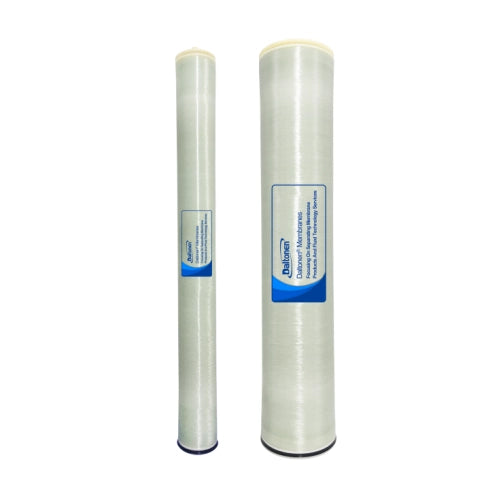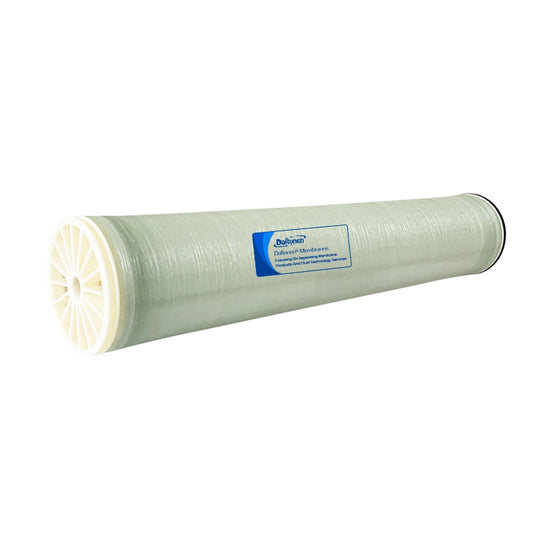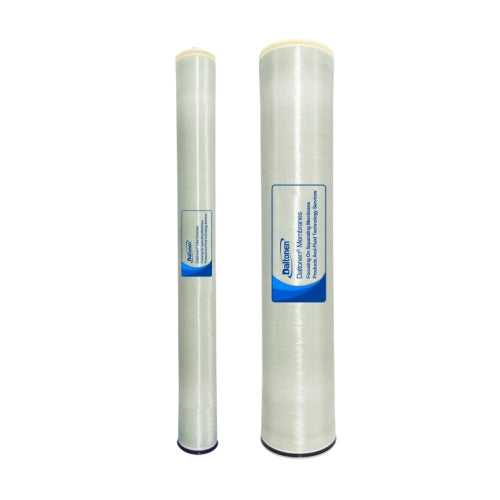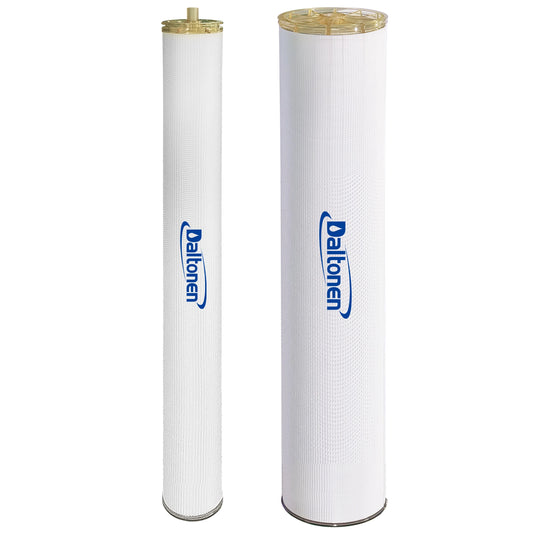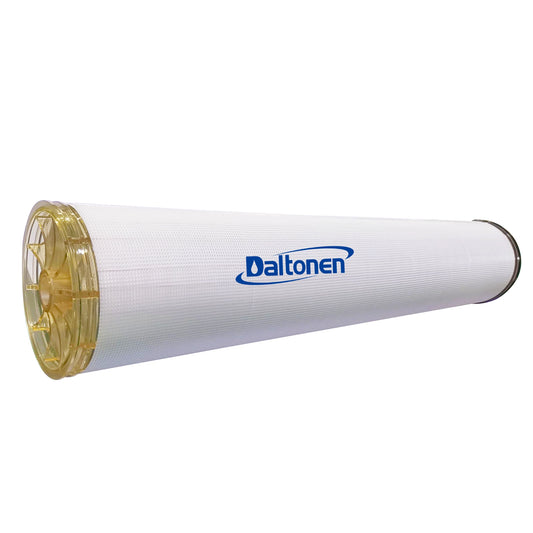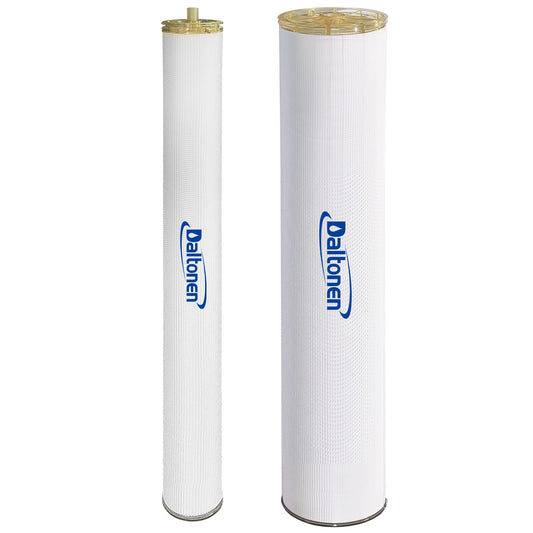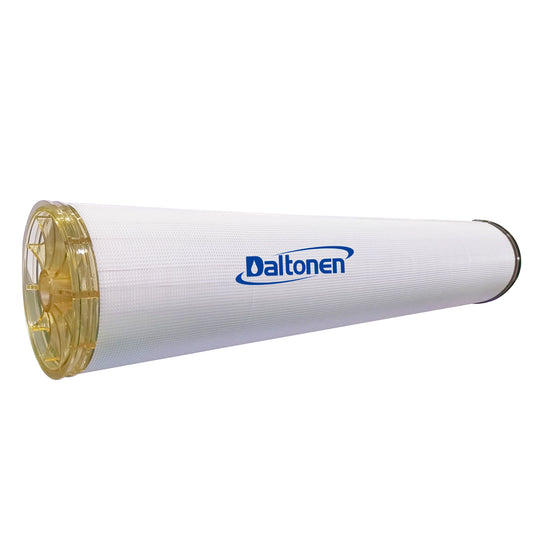How Does Nanofiltration Membrane Concentrate and Separate Peptides?
19 May 2025
1. Basic Principles of Nanofiltration Membrane Concentration and Separation of Peptides
1.1 Structure and Characteristics of Nanofiltration Membranes
Nanofiltration membranes are semipermeable membranes with nanoscale pore sizes, typically ranging from 1 to 10 nanometers. This pore size enables them to effectively retain organic small molecules with relative molecular masses between 200 and 1000, such as peptides. The structure of nanofiltration membranes mainly consists of a support layer and a separation layer. The support layer is usually made of porous materials, such as polysulfone or polyethersulfone, and its primary function is to provide mechanical strength and support for the separation layer. The separation layer is typically composed of a thin polymer membrane, such as polyamide, which has a charged surface that can further enhance the retention of specific molecules through electrostatic interactions.
The characteristics of nanofiltration membranes are mainly reflected in their selective permeability. Due to their small pore size, they can effectively retain large molecular substances like peptides while allowing water and small molecular solvents to pass through. Additionally, the surface charge of nanofiltration membranes also affects their retention of peptides. For example, negatively charged nanofiltration membranes have a higher retention rate for positively charged peptides under neutral or alkaline conditions, as the electrostatic attraction enhances the interaction between peptides and the membrane surface. According to experimental data, the retention rate of peptides by nanofiltration membranes can typically reach over 80%, giving them a significant advantage in the concentration and separation of peptides.

2. Process Flow of Nanofiltration Membrane Concentration and Separation of Peptides
2.1 Pretreatment Steps
Pretreatment steps are crucial before the nanofiltration membrane concentration and separation of peptides, as they directly affect the effectiveness and efficiency of the subsequent nanofiltration operations.
-
Solution Preparation: Peptides need to be dissolved in an appropriate solvent, typically deionized water or a buffer solution. The pH and ionic strength of the solution should be optimized based on the properties of the peptides and the characteristics of the nanofiltration membrane. For example, for positively charged peptides, choosing a solution with a neutral or alkaline pH can enhance the retention effect of the nanofiltration membrane. Research indicates that when the solution pH is adjusted from 3 to 7, the retention rate of positively charged peptides on the nanofiltration membrane can increase from 60% to 90%.
-
Prefiltration: To remove large particulate impurities from the solution, such as suspended solids and colloids, prefiltration is usually necessary. Prefiltration can be performed using microfiltration membranes with pore sizes generally ranging from 0.1 to 1 micrometer. Prefiltration effectively reduces the risk of nanofiltration membrane blockage and extends the membrane's service life. Experiments have shown that the rate of membrane flux decline in solutions subjected to prefiltration is 40% lower than that of solutions not subjected to prefiltration during nanofiltration operations.
-
Solution Clarification: Further clarify the solution by methods such as centrifugation or ultrafiltration to remove tiny particles and impurities that may affect the nanofiltration process. The centrifugation speed is typically around 10,000g, and the pore size of the ultrafiltration membrane is generally between 10 and 100 nanometers. This step can significantly improve the permeation performance and separation efficiency of the nanofiltration membrane, increasing the peptide recovery rate by about 15%.
2.2 Nanofiltration Operating Conditions
Optimization of nanofiltration operating conditions is a key factor in achieving efficient peptide concentration and separation.
-
Operating Pressure: Nanofiltration operations are typically conducted within a pressure range of 0.5 to 5 MPa. The operating pressure directly affects the membrane flux and peptide retention rate. Experimental data show that when the operating pressure is increased from 0.5 MPa to 3 MPa, the flux of the nanofiltration membrane can increase by approximately threefold. However, further increasing the pressure can cause irreversible damage to the membrane, reducing its service life. For example, in a certain study, when the operating pressure exceeded 3.5 MPa, the retention rate of the nanofiltration membrane decreased by about 10%, and the membrane flux did not increase significantly. Therefore, selecting an appropriate operating pressure is crucial for balancing flux and membrane life, and it is generally recommended to operate within the range of 2 to 3 MPa to achieve the best concentration and separation effects.
-
Temperature Control: The temperature for nanofiltration operations is generally between 15℃ and 40℃. Temperature affects both the permeation performance of the membrane and the stability of the peptides. Higher temperatures can increase the fluidity of the solution, thereby enhancing membrane flux. However, excessively high temperatures may lead to peptide denaturation. Research indicates that at 30℃, the flux of the nanofiltration membrane is about 20% higher than at 15℃, while the activity retention rate of the peptides remains above 95%.
-
Flow Rate Adjustment: The flow rate of the solution over the surface of the nanofiltration membrane is typically between 1 and 5 m/s. A higher flow rate can reduce concentration polarization, thereby improving the membrane's permeation performance. Experiments have shown that when the flow rate is increased from 1 m/s to 3 m/s, the flux of the nanofiltration membrane can increase by approximately 25%, while the peptide retention rate remains above 90%. Therefore, reasonably adjusting the flow rate can effectively improve the efficiency of the nanofiltration operation.
-
Transmembrane Pressure Difference: The transmembrane pressure difference is an important parameter in nanofiltration operations, usually ranging from 0.1 to 1 MPa. The size of the transmembrane pressure difference directly affects the permeation performance of the membrane and the retention effect of the peptides. Experimental data show that when the transmembrane pressure difference is increased from 0.1 MPa to 0.5 MPa, the flux of the nanofiltration membrane can increase by about 40%. However, further increasing the transmembrane pressure difference can increase the risk of membrane blockage. Therefore, it is necessary to optimize the transmembrane pressure difference according to specific operating conditions to achieve the best nanofiltration effect.
3. Factors Affecting the Effect of Nanofiltration Membrane Concentration and Separation of Peptides
3.1 Operating Pressure
Operating pressure is one of the key factors affecting the effect of nanofiltration membrane concentration and separation of peptides. Nanofiltration operations are typically conducted within a pressure range of 0.5 to 5 MPa. Experimental data show that when the operating pressure is increased from 0.5 MPa to 3 MPa, the flux of the nanofiltration membrane can increase by approximately threefold. This is because higher pressure can increase the flow rate of the solution, thereby enhancing the permeation rate of the solvent. However, further increasing the pressure can cause irreversible damage to the membrane, reducing its service life. For example, in a certain study, when the operating pressure exceeded 3.5 MPa, the retention rate of the nanofiltration membrane decreased by about 10%, and the membrane flux did not increase significantly. Therefore, selecting an appropriate operating pressure is crucial for balancing flux and membrane life, and it is generally recommended to operate within the range of 2 to 3 MPa to achieve the best concentration and separation effects.
3.2 Solution pH Value
The pH value of the solution significantly affects the effect of nanofiltration membrane concentration and separation of peptides. The surface charge characteristics of nanofiltration membranes make their retention of peptides closely related to the pH value of the solution. For example, negatively charged nanofiltration membranes have a higher retention rate for positively charged peptides under neutral or alkaline conditions. This is because electrostatic attraction enhances the interaction between peptides and the membrane surface. Research indicates that when the solution pH is adjusted from 3 to 7, the retention rate of positively charged peptides on the nanofiltration membrane can increase from 60% to 90%. Additionally, the pH value of the solution also affects the solubility and stability of peptides. Under acidic conditions, the solubility of peptides may decrease, leading to the formation of precipitates that can block the nanofiltration membrane. Therefore, optimizing the pH value of the solution not only improves the retention effect of the nanofiltration membrane but also reduces the risk of membrane blockage and extends the membrane's service life. It is generally recommended to adjust the solution pH to between 6 and 8 based on the isoelectric point of the peptides and the surface charge characteristics of the nanofiltration membrane to achieve the best separation effect.
3.3 Peptide Solution Concentration
The initial concentration of the peptide solution also has an important impact on the effect of nanofiltration membrane concentration and separation. Higher solution concentrations can lead to more significant concentration polarization phenomena, thereby reducing membrane flux. Experimental data show that when the initial concentration of the peptide solution is increased from 1 g/L to 5 g/L, the flux of the nanofiltration membrane decreases by about 30%. This is because the concentration polarization layer formed by the high concentration solution on the membrane surface hinders the permeation of the solvent. However, higher solution concentrations also have their advantages, as they can increase the recovery rate of peptides and reduce the volume of solution required for concentration. Research indicates that within a certain concentration range, the recovery rate of peptides increases with the increase in solution concentration. For example, when the solution concentration is increased from 1 g/L to 3 g/L, the recovery rate of peptides increases from 80% to 90%. Therefore, in actual operations, it is necessary to reasonably select the initial concentration of the peptide solution based on specific separation requirements and goals to balance the relationship between flux and recovery rate. It is generally recommended to control the solution concentration between 2 and 3 g/L to achieve higher flux and recovery rates.

4. Application Cases of Nanofiltration Membrane Concentration and Separation of Peptides
Nanofiltration membrane technology for peptide concentration and separation has been widely applied in various fields, and the following are some typical application cases.
4.1 Pharmaceutical Industry
In the pharmaceutical industry, during the production process of peptide drugs, nanofiltration membrane technology is used for peptide concentration and purification, effectively increasing the recovery rate and purity of peptides. For example, in a certain pharmaceutical company's production of a peptide anticancer drug, nanofiltration membrane technology was used for concentration and separation. By optimizing operating conditions, such as controlling the operating pressure at 2.5 MPa, the solution pH at 7.0, and the solution concentration at 2.5 g/L, the recovery rate of peptides reached 92%, and the purity increased from 50% to 85%. This not only increased the yield and quality of the drug but also reduced production costs and shortened the production cycle.
4.2 Food Industry
In the food industry, peptides are used as functional food additives, such as peptides with antioxidant and antimicrobial properties, and their concentration and separation are crucial for increasing product added value. For example, in the production of a protein drink rich in antioxidant peptides, nanofiltration membrane technology was used to concentrate peptides. Experiments showed that under operating conditions of 3 MPa pressure, pH 6.5, and 2 g/L solution concentration, the concentration factor of peptides reached 10 times, and the activity retention rate of peptides was above 90%. Eventually, the content of peptides in the protein drink significantly increased, and its antioxidant capacity improved by about 40%, enhancing the product's market competitiveness.
4.3 Cosmetics Industry
In the cosmetics industry, peptides are important active ingredients, and their concentration and separation are significant for improving the efficacy and stability of cosmetics. For example, in the production of an anti-wrinkle essence containing collagen peptides, nanofiltration membrane technology was used to concentrate collagen peptides. By controlling the operating pressure at 2 MPa, the solution pH at 6.8, and the solution concentration at 3 g/L, the recovery rate of collagen peptides reached 95%, and the purity increased from 60% to 90%. After concentration and separation by nanofiltration membrane, the stability of collagen peptides in cosmetics significantly improved, and the anti-wrinkle effect of the product was significantly enhanced, with customer satisfaction reaching over 90%.
4.4 Biomedical Research Field
In the biomedical research field, nanofiltration membrane technology is used for peptide concentration and separation, providing high-purity peptide samples for biological experiments. For example, in a certain biomedical laboratory conducting pharmacological research on peptide drugs, it was necessary to concentrate and separate the synthesized peptides. By using nanofiltration membrane technology under operating conditions of 2.8 MPa pressure, pH 7.2, and 1.5 g/L solution concentration, the recovery rate of peptides reached 90%, and the purity reached 98%. High-purity peptide samples provided a reliable guarantee for subsequent biological experiments, significantly improving the accuracy and reproducibility of experimental results and providing strong support for peptide drug development.
5. Advantages of Nanofiltration Membrane Concentration and Separation of Peptides
5.1 Low Energy Consumption
The process of nanofiltration membrane concentration and separation of peptides has significant advantages in low energy consumption, mainly reflected in the following aspects:
-
Lower Operating Pressure: Nanofiltration operations are typically conducted within a pressure range of 0.5 to 5 MPa. Compared with traditional methods such as evaporative concentration, the required pressure is lower. For example, traditional evaporative concentration requires operation at higher temperatures and pressures, resulting in higher energy consumption. Nanofiltration membrane operations generally require an operating pressure of only 2 to 3 MPa to achieve efficient concentration and separation, with energy consumption being only one-third to one-half that of traditional evaporative concentration.
-
Lower Temperature Requirements: The temperature for nanofiltration operations is generally between 15℃ and 40℃, which is considered ambient or mild temperature operation. This temperature range is far lower than the high-temperature conditions required by traditional thermal concentration methods, thereby avoiding the significant energy consumption associated with high-temperature heating. For example, when processing heat-sensitive peptides, nanofiltration membrane technology can operate at lower temperatures, ensuring the activity of peptides while reducing energy consumption.
-
No Additional Chemical Reagents: The process of nanofiltration membrane concentration and separation does not require the addition of large amounts of chemical reagents, such as precipitants and extractants. The use of these chemical reagents not only increases production costs but also leads to additional energy consumption for the preparation, mixing, and subsequent treatment of reagents. Nanofiltration membrane technology relies on the physical and chemical properties of the membrane to achieve separation, eliminating the need for additional chemical reagents and thereby reducing overall energy consumption.
-
High Separation Efficiency: The retention rate of peptides by nanofiltration membranes can typically reach over 80%, enabling efficient concentration and separation in fewer steps and in a shorter time. This means that for the same processing volume, the energy consumption of nanofiltration membrane technology is lower. For example, in a certain pharmaceutical company using nanofiltration membrane technology to concentrate peptides, compared with traditional methods, the energy consumption for processing the same volume of peptide solution was reduced by about 40%.
5.2 Good Product Property Maintenance
Nanofiltration membrane concentration and separation of peptides can effectively maintain the product properties of peptides, mainly reflected in the following points:
-
Maintaining Peptide Biological Activity: The operating conditions of nanofiltration membranes are mild, with temperature and pressure both within lower ranges, and will not negatively affect the biological activity of peptides. For example, at 30℃, the flux of the nanofiltration membrane is about 20% higher than at 15℃, while the activity retention rate of peptides remains above 95%. This indicates that during the process of nanofiltration membrane concentration and separation, the biological activity of peptides can be well maintained, which is crucial for the application of peptides in the pharmaceutical, biomedical research, and other fields.
-
Reducing Peptide Denaturation Risk: The small pore size of nanofiltration membranes can effectively retain large molecular substances such as peptides while allowing water and small molecular solvents to pass through. This characteristic ensures that peptides are not exposed to adverse factors such as intense shear forces and high temperatures during the concentration process, thereby reducing the risk of peptide denaturation. For example, in a certain biomedical laboratory during peptide concentration, using nanofiltration membrane technology under operating conditions of 2.8 MPa pressure, pH 7.2, and 1.5 g/L solution concentration, the recovery rate of peptides reached 90%, the purity reached 98%, and the biological activity of peptides did not change significantly.
-
Maintaining Peptide Purity and Stability: The surface charge and pore size characteristics of nanofiltration membranes enable them to selectively retain peptides while removing impurities and small molecular substances from the solution. This not only increases the purity of peptides but also enhances their stability. For example, in the cosmetics industry, using nanofiltration membrane technology to concentrate collagen peptides, the recovery rate of collagen peptides reached 95%, the purity increased from 60% to 90%, and the stability of collagen peptides in cosmetics significantly improved after concentration and separation by nanofiltration membrane, with a significant enhancement in the anti-wrinkle effect of the product.
-
Reducing Impurity Residues: Nanofiltration membranes can effectively remove impurities and small molecular substances from the solution, such as salts and pigments. The presence of these impurities may affect the properties and application effects of peptides. Through nanofiltration membrane concentration and separation, the content of impurities can be significantly reduced, improving the purity and quality of peptides. For example, in a certain pharmaceutical company's production of peptide anticancer drugs, using nanofiltration membrane technology for concentration and separation, the purity of peptides increased from 50% to 85%, and the content of impurities was significantly reduced, thereby improving the quality and safety of the drug.
6. Summary
Nanofiltration membrane technology for peptide concentration and separation, with its unique advantages, has shown great application potential in various fields. The structure and characteristics of nanofiltration membranes enable them to efficiently retain peptides, and by optimizing operating conditions such as operating pressure, solution pH, temperature, and flow rate, the concentration and separation effects can be further improved. In practical applications, nanofiltration membrane technology has achieved remarkable results in the pharmaceutical, food, cosmetics, and biomedical research fields, not only increasing the recovery rate and purity of peptides but also reducing production costs and shortening production cycles.
The advantages of nanofiltration membrane concentration and separation of peptides are mainly reflected in low energy consumption and good product property maintenance. Compared with traditional concentration methods, nanofiltration membrane technology can achieve efficient concentration and separation at lower operating pressures and temperatures, without the need to add large amounts of chemical reagents, significantly reducing energy consumption. At the same time, the mild operating conditions of nanofiltration membranes can effectively maintain the biological activity of peptides, reduce the risk of peptide denaturation, increase peptide purity and stability, and reduce impurity residues, providing high-quality product guarantees for the application of peptides in various fields.
In summary, nanofiltration membrane technology for peptide concentration and separation is an efficient, energy-saving, and environmentally friendly separation technology with broad application prospects and important research value. In the future, with the continuous improvement of nanofiltration membrane materials and further optimization of operating processes, this technology is expected to be more widely applied in more fields, providing stronger support for the production and development of peptides.
Tags:
